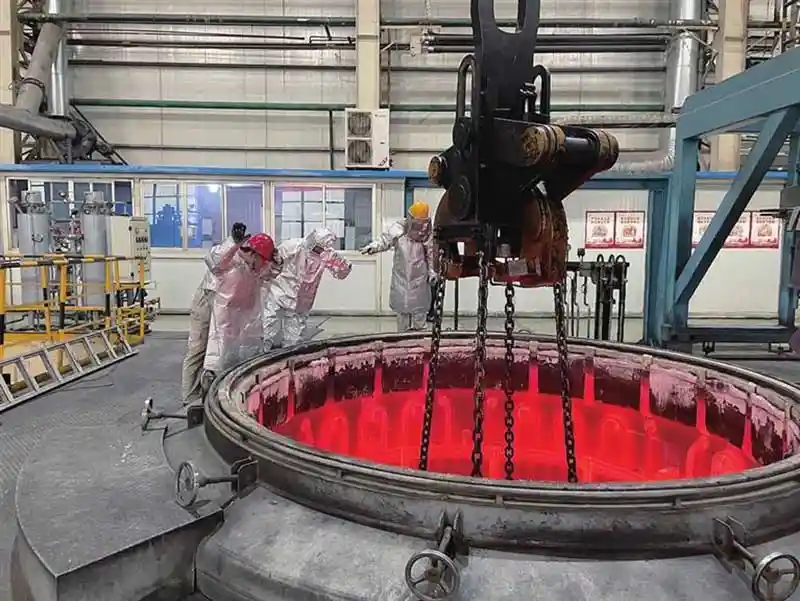Annealing is a cornerstone technique in modern manufacturing, metallurgy, and materials engineering. Whether you’re dealing with steel beams, copper wires, or semiconductor wafers, annealing plays a vital role in shaping how materials behave under stress, respond to machining, and perform over time. By carefully controlling temperature, soak time, and cooling rates, annealing allows engineers to fine-tune material properties—balancing strength, ductility, conductivity, and internal stress. This guide unpacks the annealing process from a practical, engineering-focused perspective.

What Is Annealing?
Annealing is a thermal treatment process that involves heating a material to a predefined temperature, holding it for a period (soaking), and then cooling it at a controlled rate. This process alters the microstructure of the material, typically softening it and relieving internal stresses induced during manufacturing steps like rolling, forging, machining, or welding. Common materials that undergo annealing include ferrous and non-ferrous metals (such as carbon steel, stainless steel, copper, and aluminum) and certain types of glass and ceramics.
The main goals of annealing are:
- To improve ductility and reduce brittleness, making the material easier to form or machine.
- To relieve residual stresses that could cause warping or cracking in service.
- To homogenize the microstructure and refine grain boundaries, enhancing mechanical stability and fatigue performance.
In short, annealing isn’t just a heat treatment—it’s a tool for restoring and optimizing the physical behavior of materials across a wide range of applications.
How Does Annealing Work? The Three Stages Explained
The annealing process can be broken down into three fundamental stages. Each of these stages plays a distinct role in altering the material’s internal structure and mechanical properties.
1. Recovery Stage
During the initial phase, the material is heated to a temperature where dislocation motion becomes active but no new grains are formed yet. At this stage, internal residual stresses caused by plastic deformation begin to relax. Electrical conductivity often increases slightly, while hardness decreases modestly. Although the microstructure remains largely unchanged, this stage is essential for reducing localized stress concentrations that could otherwise initiate fatigue failure.
2. Recrystallization Stage
As temperature rises further into the recrystallization range (typically 0.3–0.5 times the melting temperature in Kelvin), new, strain-free grains start to form within the deformed matrix. These grains replace the previously distorted ones, dramatically improving ductility and reducing hardness. This is the heart of the annealing process: it resets the material’s work-hardening history, allowing it to be further processed or used in critical applications without compromising reliability.
3. Grain Growth Stage
If the material remains at high temperature beyond the optimal recrystallization period, the grains begin to grow larger. This stage can enhance creep resistance in high-temperature alloys but may reduce strength due to coarsening of the grain structure. Engineers must carefully balance the benefits of grain growth with the risk of over-softening or embrittlement, especially in structural components.
How Does an Annealing Furnace Work?
An annealing furnace is a specialized piece of equipment designed to provide uniform and controllable thermal environments. These furnaces vary in size and design depending on the industry—from small-scale lab furnaces to large, continuous belt furnaces in automotive plants.
Key components include:
- Heating chamber: Typically lined with refractory materials and powered by electric resistance or gas burners to ensure consistent temperature distribution.
- Temperature controllers: Use thermocouples and PID control systems to precisely manage heat-up, soak, and cool-down profiles.
- Protective atmosphere: In many cases, annealing is conducted in inert atmospheres (e.g., nitrogen, argon) or vacuum environments to prevent oxidation and scaling.
- Cooling systems: Furnace-cooling, gas-blast, or controlled quenching allow for tailored cooling rates critical to achieving desired properties.
For instance, in the aerospace industry, vacuum annealing is often used to maintain the purity of titanium or nickel-based alloys, while the steel industry may use open-air furnaces for normalization processes.
When Is Annealing Required and Why Is It Important?
Annealing is typically necessary when a material has undergone cold working, which introduces significant dislocation density and internal stress. Without annealing, such materials may become brittle, dimensionally unstable, or prone to cracking under service loads.
Situations where annealing is essential:
- After drawing or rolling: Restores formability and prepares the metal for further shaping.
- Post-welding: Removes localized stress in the heat-affected zone (HAZ).
- Before machining: Improves machinability, reduces tool wear, and ensures dimensional accuracy.
- To enhance magnetic or electrical properties: Crucial for transformer cores and electrical connectors.
Importantly, annealing isn’t just a mechanical fix—it’s a reliability enabler. It ensures that parts can function as intended in high-stress or long-life applications.
Can Annealing Be Used with Alloys?
Yes, but with caution. Alloys exhibit more complex phase behavior than pure metals, meaning that annealing temperatures, holding times, and cooling rates must be precisely controlled to avoid unwanted phase changes.
For example:
- Carbon steels: Respond well to full annealing or normalizing to improve machinability.
- Stainless steels: Require solution annealing followed by rapid quenching to retain corrosion resistance.
- Aluminum alloys: May need annealing to restore ductility after extensive cold working.
- Nickel and titanium alloys: Require vacuum or inert gas annealing due to their high reactivity at elevated temperatures.
Understanding the phase diagram of each alloy system is essential for designing an effective annealing schedule.
What Are the Types of Annealing?
Each annealing method targets a specific material condition or engineering goal:
Diffusion Annealing
High-temperature treatment to homogenize composition in cast or forged parts. Usually done at 1100–1300°C for 8–20 hours.
Stress Relief Annealing
Low-temperature annealing (typically 500–700°C) used to remove internal stresses from machining, forming, or welding.
Normalisation Annealing
Steel is heated above the critical point and cooled in still air. Produces fine-grained, uniform structures ideal for structural applications.
Spherification (Spheroidizing) Annealing
Used in high-carbon steels to transform lamellar pearlite into globular cementite, significantly enhancing machinability.
Incomplete Annealing
Partial phase transformation aimed at adjusting mechanical properties without full softening—useful in sheet metal applications.
Complete Annealing
Full transformation to equilibrium microstructure. Often used to prepare steel for forming or further heat treatment.
Recrystallisation Annealing
Eliminates effects of cold work by producing new grains. Critical in foil, wire, and tube manufacturing.
Isothermal Annealing
Involves holding the material at an intermediate transformation temperature before final cooling. Ensures predictable microstructure and hardness.
How Much Time Is Required for Annealing?
Time depends on:
- Material type: Different alloys have different thermal conductivities and transformation kinetics.
- Part geometry and thickness: Thicker sections require longer soak times to achieve uniform temperature.
- Furnace characteristics: Thermal inertia, heat transfer efficiency, and control systems all influence total cycle time.
A general rule: 1 hour per inch of material thickness, but advanced simulations and thermodynamic software are often used for precise thermal profiling in aerospace or nuclear applications.
What Are the Advantages of Annealing?
- Improved ductility: Makes forming, stamping, and drawing operations more efficient.
- Stress relief: Minimizes distortion and cracking during service.
- Enhanced machinability: Reduced tool wear and improved surface finish.
- Consistent microstructure: Improves fatigue life and fracture resistance.
- Electrical conductivity: Especially important in copper alloys used for power transmission.
For manufacturers, this means fewer part failures, reduced scrap rates, and longer tool life.
Does Annealing Improve the Machinability of Metals?
Absolutely. Annealed metals cut more cleanly, require lower cutting forces, and reduce chatter and tool breakage. This is especially evident in:
- High-carbon steels after spheroidizing
- Aluminum alloys after soft annealing
- Copper and brass wires before fine drawing or bending
For high-speed production lines, the cost savings from reduced tooling wear and faster cycle times are substantial.
What Are the Disadvantages of Annealing?
- Energy consumption: Heating large parts to high temperatures is energy-intensive.
- Time inefficiency: Long soaking and cooling periods reduce throughput.
- Oxidation/scaling: Surface degradation can occur if not conducted in inert atmospheres.
- Risk of over-annealing: Grain coarsening or phase instability can reduce strength and surface quality.
For high-volume manufacturers, these drawbacks necessitate careful process integration and real-time thermal monitoring.
What Are the Applications of Annealing?
Annealing supports a vast range of industries and products:
- Automotive: Improves formability of body panels and engine parts.
- Aerospace: Enhances fatigue resistance in titanium and Inconel components.
- Electronics: Recovers conductivity in fine copper interconnects.
- Glass manufacturing: Prevents stress fractures in tempered glass.
- Metal forming: Essential for deep drawing, extrusion, and forging processes.
Essentially, if you’re shaping, cutting, or heating a material—annealing is likely part of the workflow.
Who Discovered Annealing? A Brief History
The roots of annealing date back to ancient blacksmiths, who learned by observation that heated metal was easier to shape and less prone to cracking. Systematic study began in the 19th century with the rise of materials science. Today, international bodies such as ASM International, TWI, and DIN/ISO define global standards for annealing processes.
Heat Treatment Services & Support
TWI Ltd (Head Office)
TWI offers advanced heat treatment consulting, testing, and failure analysis services, with decades of experience in metallurgy, welding, and additive manufacturing.
Group Companies
From Europe to Asia, TWI subsidiaries provide regional support for complex industrial heat treatment needs, including furnace setup, process control, and failure mitigation.
Final Words
Annealing is not just a thermal process—it’s an engineering strategy. From restoring formability in rolled steel to preserving purity in semiconductor wafers, annealing supports the performance, safety, and manufacturability of countless products. Understanding the science and variables behind annealing allows engineers to make better decisions, optimize production, and create more reliable designs.
FAQs
Q: Is annealing the same as tempering?
No. Annealing softens the material and restores ductility, while tempering is used after quenching to reduce brittleness without drastically lowering hardness.
Q: Can annealing be done at home or in small workshops?
For certain metals like copper or mild steel, yes. However, industrial annealing requires precise control of time, temperature, and atmosphere.
Q: What’s the typical annealing temperature for steel?
Usually between 700–950°C, depending on the alloy composition and desired final structure.
Q: Does annealing increase or decrease hardness?
Generally, annealing decreases hardness while increasing ductility.
Q: Can all metals be annealed?
Most can, but the procedure must be tailored to each metal or alloy system to avoid undesired transformations.


